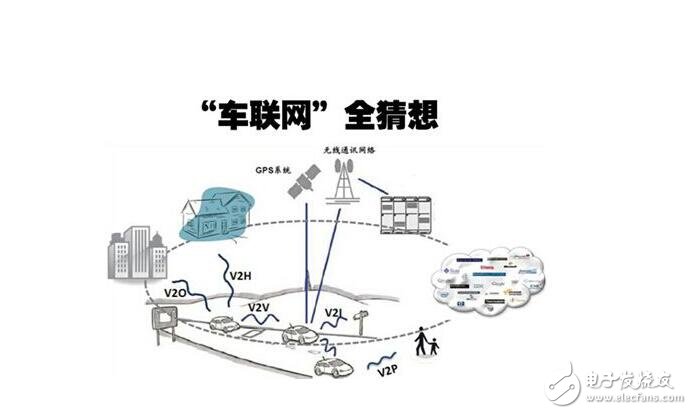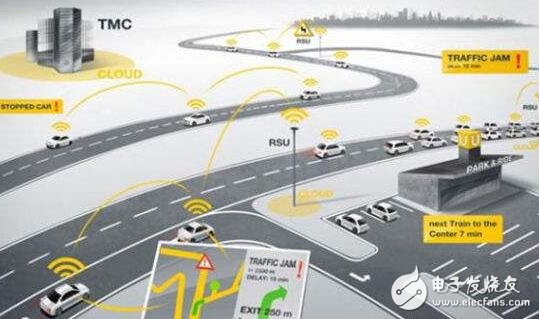The definition of the Internet of Vehicles is different according to the industry background. The traditional vehicle networking is defined as the electronic tag installed on the vehicle to extract the vehicle information through radio frequency and other technologies, so as to effectively supervise and provide an integrated service system. However, with the rapid development of Internet technology and various industries, the traditional definition of car networking is not enough to cover the entire content of today's car networking, according to the definition of strategic alliance of technology innovation in the car networking industry.
The vehicle network is based on the in-vehicle network, the inter-vehicle network and the in-vehicle mobile Internet. In accordance with the agreed communication protocol and data interaction standards, wireless communication and information exchange between vehicles and people, vehicles and roads, vehicles and the Internet are carried out. The large system network, and then the system realizes the "filter cleaning" of massive data, the platform processes the data, and realizes the integrated network of intelligent traffic management, intelligent dynamic information service and vehicle intelligent control, which is the Internet of Things technology. Typical applications in the field of transportation systems.
Car networking system
Vehicle networking system refers to the use of advanced intelligent technology, sensing technology, network technology, computing technology, and control technology to make the system fully aware of roads and traffic, so that all vehicles can collect information through their own environment and state, and All kinds of information of its own are uploaded to the Internet big data platform, and the central processor collects, analyzes and processes a large amount of uploaded information. The system will control each vehicle involved in the traffic, and control each road in real time for use. Provide traffic efficiency and safety.
The importance of car networking
Internet of Vehicles (IOV) is a subdivision application of the Internet of Things in the automotive field. It is the only way for the mobile Internet and the Internet of Things to develop into the essence and depth of the business. It is the future development of information communication, environmental protection, energy conservation and security. Convergence technology.
The “car-road†information system has always been a key area for the development of intelligent transportation. Internationally, European CVIS, American IVHS, and Japan's SmartWay system realize intelligent traffic management and information services by establishing effective information communication between vehicles and roads. In recent years, RFID technology has been applied in the field of logistics and supply chain management and intelligent management of transportation, such as intelligent bus location management and signal priority, intelligent parking lot management, vehicle type and traffic information collection, road and bridge electronic non-stop charging, The application of highway ambiguous path identification and vehicle speed calculation and analysis has achieved certain results.

1. The car machine is the abbreviation of the car infotainment product installed in the car. The car machine can realize the interaction between the driver and the vehicle and the car in some functions, and increase the driver's user experience and safety factor. Some cars include functions such as scheduled maintenance, remote diagnosis, telephone call, voice control, and vehicle rescue.
2, smart phones, domestic products represented by Baidu Carnet, foreign products represented by Apple carplay, android auto. The driver can project the contents of the mobile phone onto the screen of the car, making the vehicle intelligent system more flexible and malleable, giving the driver a more convenient feeling of getting started.
3, map navigation, many vehicles have navigation, but due to slow version updates and other issues, the actual use is very small, the average driver has turned to use the mobile APP to operate.
4. Voice technology, the key technologies in the computer field are automatic speech recognition technology (ASR) and speech synthesis technology (TTS). It is the development direction of human-computer interaction in the future, and voice becomes the most promising human-computer interaction in the future. Voice has more advantages than other ways of interacting, and voice technology will become an important part of the Internet of Vehicles.
WCDMA/LTE mobile communication technology, in-vehicle Wi-Fi and 3G/4G and other secure, high-speed mobile communication technologies provide the possibility for the fast-moving vehicle to access the Internet, and also bring huge benefits to mobile operators. In-vehicle Wi-Fi is a special Internet access device for modern vehicles. In-vehicle Wi-Fi transforms mobile vehicles into a mobile network, and operators obtain location information of mobile terminal users through LBS (LocaTIon Based Service). With the support of the GIS platform, users are provided with corresponding services, so that drivers or passengers can enjoy the ubiquitous information service. Therefore, in-vehicle Wi-Fi technology and WCDMA/LTE mobile communication technology will become a key part of smart cars.
5, HUD (Head Up Display), nowadays many luxury cars have their own simple HUD accessories, but only simple real-time speed and simple navigation mapping. However, many domestic and foreign technology companies have begun to design and develop new HUDs. Even the front windshield is a large HUD. It can be operated by the driver's limb control, human-computer interaction or the interior sensor. The driver got rid of the phone and solved the distraction.
6, OBD (On-Board DiagnosTIc on-board diagnostic system), OBD initially can monitor the car's emissions by monitoring the car's power and emissions control system. When the vehicle's power or emission control system fails, the fault light will illuminate when the amount of pollution exceeds the set standard. Nowadays, OBD is integrated into detection, maintenance and management. The system will enter the ECU (Electronic Control Unit electronic control unit, also known as "driving computer") of the engine, gearbox and other systems to read the fault code and other related data. Now part of OBD has integrated GPS chip, acceleration sensor, etc., can obtain driving data, combined with mobile phone App can play a certain security role (vibration, displacement, ignition alarm), real-time monitoring of vehicle conditions.
7, CAN (Controller Area Network), is one of the most widely used fieldbuses in the world. In recent years, its high reliability and good error detection capability have been valued and widely used in automotive computer control systems.
8, RFID (Radio Frequency IdenTIficaTIon radio frequency identification technology), is a communication technology that can identify specific targets and read and write related data through radio signals without identifying mechanical or optical contact between the system and a specific target. In fact, RFID is very familiar to everyone, and the various access cards we use are based on this technology. RFID has ETC, parking lot, parking space guidance, special vehicle management, etc. for vehicle assisted or managed systems.
9. ITS (Intelligent Transport System) is the development direction of the future transportation system. It is the effective integration of advanced information technology, data communication transmission technology, electronic sensing technology, control technology and computer technology into the entire ground. The traffic management system is a real-time, accurate and efficient integrated transportation management system that works in a wide range and in all directions. ITS can effectively utilize existing transportation facilities, reduce traffic load and environmental pollution, ensure traffic safety, and improve transportation efficiency. The 21st century will be the century of intelligent road traffic. The intelligent transportation system that people will adopt is an advanced integrated transportation management system.

The position loop and speed loop are formed inside the industrial Servo Motor, and the control performance is reliable. The AC servo system is closed-loop control, suitable for cross-cutting machines, printing machinery, CNC machine tools, automatic control centers, steel bar bending machines and other fields. It can provide dealers and end users with a rich supply of servo motor products, which can meet the needs of customers for centralized procurement, and is conducive to maintaining long-term and stable customer cooperation relationships, maintaining a high market share, and avoiding the problem of long delivery times.
Industrial Servo Motor,Industrial Servo,High Torque Industrial Servo Motor,Small Industrial Servo Motor
Kassel Machinery (zhejiang) Co., Ltd. , https://www.kasselservo.com